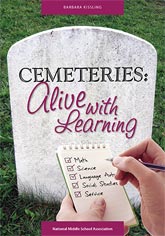Cemeteries: Alive with Learning
Cemeteries: Alive with Learning
by Barbara Kissling
(AMLE, 2010 – Learn more)
Many times students are unable to make connections between what they learn in school and their own lives. This inability to make connections inhibits the learning process of our students and often results in the loss of student interest. Our current test-oriented curriculum has forced many teachers to forgo hands-on activities in exchange for drill and practice. Cemeteries: Alive with Learning addresses this problem with an imaginative and exhilarating interdisciplinary unit that meets state requirements and effectively prepares students for standardized tests while engaging students.
Concept

The amount of engaging activities are endless! Kissling gives several examples of lessons, and I see an endless supply of learning opportunities beyond what she has introduced in her book.
Kissling states that the book describes “the development and implantation of a successful long-term cemetery project and provides information, ideas, and suggestions that will help you envision and plan your own cemetery-based study.” As an added bonus, she provides a generous list of resources to her readers that can further their cemetery adventure.
First step: Buy-in
This is an incredibly unique concept, and buy-in from parents, students and especially administration is imperative. Without the support of these individuals the project will fall flat. The question of “Why a cemetery?” will once again play an essential role. Why not investigate something else like an historic home or the family trees of students? While these are all intriguing topics, the cemetery project appeals to the middle student’s legendary curiosity. And not only does this project have the potential to address core curriculum concepts, but it can provide students with experiences that potentially allow them to give back to their community.
Looking for an approach to bring new life to your classroom, something a little different that will do a better job of preparing students for tests and for life? Cemeteries: Alive with Learning gives practical, tested strategies for channeling young adolescents’ boundless energy, natural curiosity, creativity, and expanding skill sets to learn and practice 21st century skills. Watch their communication skills and critical thinking take flight as they analyze and interpret authentic data. Cemeteries is a true cross curriculum book featuring specific chapters on math, science, social studies, language arts, and service learning.” – From the back cover
Implementation
Kissling implemented Cemeteries: Alive With Learning as a long-term interdisciplinary unit with 6th graders. This method seemed to work fantastically for her and her teammates, but I do not see that this would be a feasible option in my middle school or for many educators. My vision for this project is as a year-long or semester-long unit of study for my gifted and talented students.
A cemetery project seems like something that would be just right for a group of GT students. I also believe that limiting the number of students that the project impacts would greatly reduce angst among parents and administrators. For one thing, you must find a feasible cemetery to study and travel there. You must also manage the group of students in a large outdoor space. A smaller group of students would minimize potential issues.
The idea of a cemetery-based project should be approached as a positive experience and not as a focus on death, and Kissling does a very good job of this in her topics of study: weathering, data collecting, graphing, charting, statistics, research and presentation.
The only issue I see with the project is the lack of technology use. The only technology implemented is GPS, Excel, digital cameras, and graphing calculators. In today’s world of learning, technology is essential. I believe that this would be an easy fix for most educators, but it would have been nice to see Kissling’s students using different modes of technology.
Read a Teaching Tolerance article by Barbara Kissling about her cemetery project
Final Thoughts
Holistic projects are a way to engage students in learning while having fun. Cemeteries: Alive with Learning does this is in a unique way. The benefits of this project far outweigh the work required to develop it. Students, staff, parents and the community benefit from projects that focus on an everyday space. I look forward to implementing this in my GT program next school year.
Carolyn Baker is a gifted-and-talented teacher and chair of the science department at Sunnyvale (TX) Middle School (the Raiders). She’s also taught high school Pre-AP Biology and Human Anatomy and Physiology — and even taught pre-K at the Little Red Schoolhouse in her hometown of Mesquite, Texas for 2 years. She holds an undergraduate degree in English and Biology from Southern Methodist University and a masters in secondary education from the University of North Texas.


































